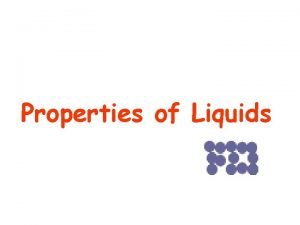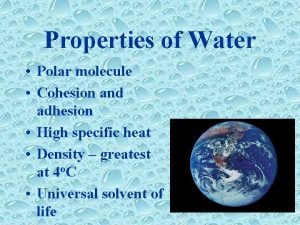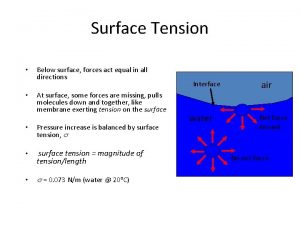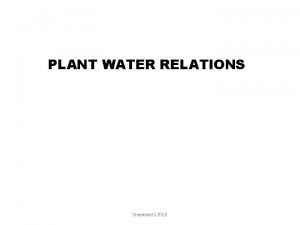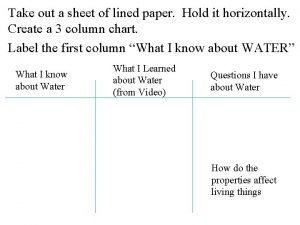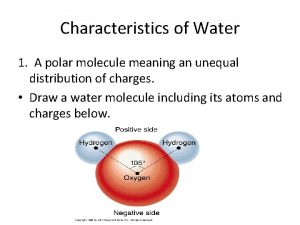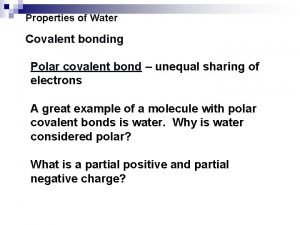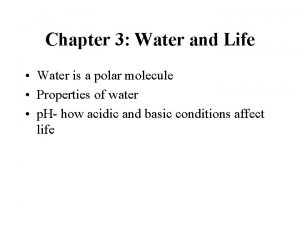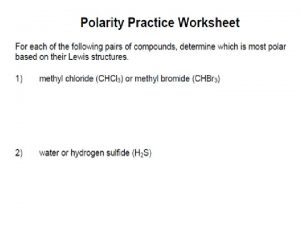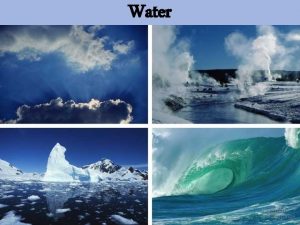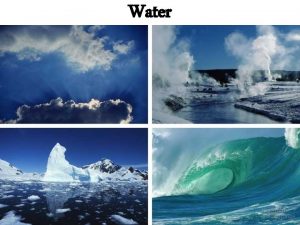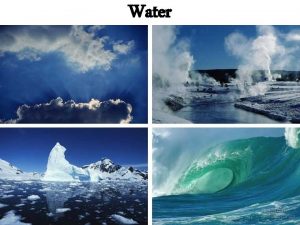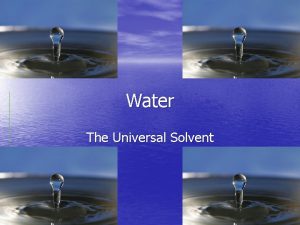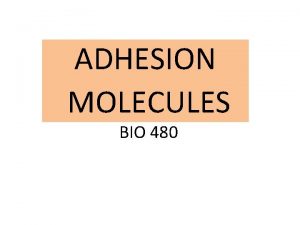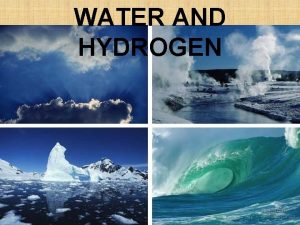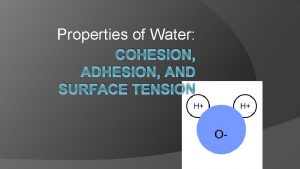Properties of Water Polar molecule Cohesion and adhesion











- Slides: 11

Properties of Water • Polar molecule • Cohesion and adhesion • High specific heat • Density – greatest at 4 o. C • Universal solvent of life

HYDROGEN BONDS • Hold water molecules together • Each water molecule can form a maximum of 4 hydrogen bonds • The hydrogen bonds joining water molecules are weak, about 1/20 th as strong as covalent bonds. • They form, break, and reform with great frequency • Extraordinary Properties that are a result of hydrogen bonds. – – – Cohesive behavior Resists changes in temperature High heat of vaporization Expands when it freezes Versatile solvent

Cohesion Hydrogen bonds hold water molecules together, so that water is sticky • Cohesion is responsible for the transport of the water column in plants • Cohesion among water molecules plays a key role in the transport of water against gravity in plants • Examples from the lab:

Surface Tension • A measure of the force necessary to stretch or break the surface of a liquid, caused by cohesion. – Water has a greater surface tension than most other liquids because hydrogen bonds among surface water molecules resist stretching or breaking the surface. Examples from lab:

Adhesion • The hydrogen bonds in water are also good at “sticking” to other polar substances, such as the bowl of your sink or a blade of grass. • Capillary action is related to adhesion and is the ability of a liquid to flow opposition to gravity as water “adheres” up a narrow column made of a polar substance, like glass or plastic. • Lab Examples:

– When water reaches 0 o. C, water becomes locked into a crystalline lattice with each molecule bonded to to the maximum of four partners. – As ice starts to melt, some of the hydrogen bonds break and some water molecules can slip closer together than they can while in the ice state. – Ice is about 10% less dense than water at 4 o. C. Fig. 3. 5 Copyright © 2002 Pearson Education, Inc. , publishing as Benjamin Cummings

Density of Water • Most dense at 4 o. C • Contracts until 4 o. C • Expands from 4 o. C to 0 o. C The density of water: 1. Prevents water from freezing from the bottom up. 2. Ice forms on the surface first—the freezing of the water releases heat to the water below creating insulation. 3. Makes transition between season less abrupt.

Moderates Temperatures on Earth Water stabilizes air temperatures by absorbing heat from warmer air and releasing heat to cooler air. Water can absorb or release relatively large amounts of heat with only a slight change in its own temperature. Celsius Scale at Sea Level 100 o. C Water boils 37 o. C 23 o. C Human body temperature Room temperature 0 o. C Water freezes • • • What is kinetic energy? Heat? Temperature? Calorie? What is the difference in cal and Cal? • What is specific heat?

Specific Heat is the amount of heat that must be absorbed or lost for one gram of a substance to change its temperature by 1 o. C. Water has a really high specific heat, meaning it takes a lot of energy to raise its temperature. 1. Prevention of temperature fluctuations that are outside the range suitable for life. 2. Coastal areas having a mild climate 3. A stable marine environment

Evaporative Cooling • The cooling of a surface occurs when the liquid evaporates • This is responsible for: – Moderating earth’s climate – Stabilizes temperature in oceans/lakes – Preventing organisms from overheating

Universal Solvent • Water (solvent) is wicked good at dissolving other polar substances (substrates), but terrible at dissolving non-polar substances. • Examples from Lab:
 Adhesive and cohesive force
Adhesive and cohesive force Adhesion and cohesion in dentistry
Adhesion and cohesion in dentistry Adhesion cohesion
Adhesion cohesion Adhesion cohesion
Adhesion cohesion Adhesion cohesion
Adhesion cohesion Water potential in transpiration
Water potential in transpiration Cohesion or adhesion
Cohesion or adhesion Polar molecule meaning
Polar molecule meaning Water covalent bonding
Water covalent bonding Polar covalent bond in water molecule
Polar covalent bond in water molecule Water is a polar molecule
Water is a polar molecule Water and water and water water
Water and water and water water
